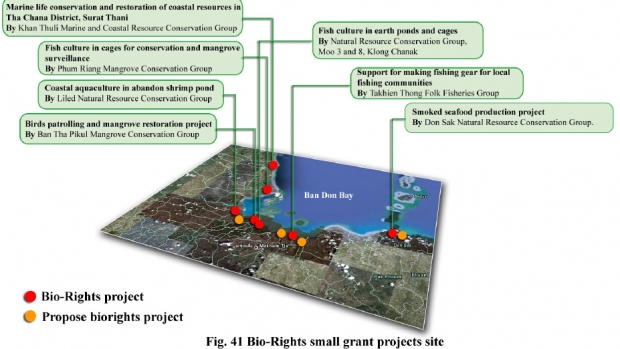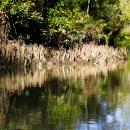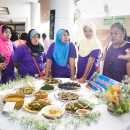Grants :: Large Grant Facilities :: Reversing environmental damage through community focused sustainable livelihoods in Ban Don Bay, Surat Thani Province, Southern Thailand
Reversing environmental damage through community focused sustainable livelihoods in Ban Don Bay, Surat Thani Province, Southern Thailand

Bio-Right projects in Suratthani, Thailand, Suratthani © Pratheep Mekatitham, 2012
Objectives
Establish a sustainable development model to restore and manage mangrove forests, while supporting conservation of coastal marine natural resources and the livelihoods of local populations, through an innovative model of local income generation.
In particular, the project aimed to:
- Conserve and restore degraded mangrove ecosystems around Ban Don Bay, particularly in the Liled subdistrict;
- Introduce a community-based grants approach ("Bio Rights") to manage and restore mangroves, and to build capacity of local communities in overseeing mangrove resources;
- Promote cooperation, among various sectors from the government, academia, private organizations and communities, in mangrove management; and
- Strengthen capacity and awareness at local and national levels of the importance of conservation and sustainable use of mangrove ecosystems and resources.
Background
Aquaculture, particularly shrimp farming, has expanded enormously along the coasts of Thailand during the past two decades. The high demand of the Black Tiger Prawn, Penaeus monodon, for export influenced the rapid growth of the shrimp farming sector. Very high short-term financial profits had negative consequences, as shrimp farming has contributed to environmental problems related to water pollution and wide-scale mangrove forest conversion. In many cases, intensive shrimp farming has been characterized by a boom-and-bust cycle of rapid expansion followed by a crash. As a result the farmers migrated from the Inner Gulf of Thailand to southern areas (Prachuap Khiri Khan, Surat Thani, and Nakhon Si Thammarat) and later across to the Andaman coast (Krabi, Phang-Nga and Satun). This shifting cultivation, combined with degradation from unsustainable logging practices, has left behind large areas of abandoned ponds and degraded mangrove forests.
Vast areas of mangrove--traditionally used by local people for fisheries, timber production and non-timber forest products--have been converted to shrimp aquaculture ponds. Unsustainable environmental practices, including reliance on high nutrient, chemical and bio-chemical inputs, severely degrades land quality; and after only 5 to 10 years use, shrimp aquaculture ponds are abandoned and investors establish new ponds in other mangrove areas. While short-term economic benefits of this “shifting aquaculture” tend to be reaped by elite of influential investors, rural communities experience the permanent loss of local natural resources upon which their traditional livelihoods depend.
Like many other areas of Thailand and beyond, this is the case for the project target areas in Surat Thani province. Land conversion for shrimp aquaculture has caused the loss of over 90% of the project area’s mangrove forests. For the local population this has led to loss of resource access, loss of traditional livelihoods, unemployment and marginalisation.
Global and national, local stakeholders profit from the long term benefits of healthy, intact mangrove forests and local people will benefit from improved livelihoods. The Bio-Rights approach which has been implemented by the project, was tested and refined by Wetlands International for more than 10 years in Asian and African countries and has the potential to effectively increase income of local communities while at the same time enhancing conservation and wise use of natural resources. During the MFF project life, Wetlands International-Thailand Office replicated the Bio-rights approach from a similar project in Tha Kham sub-district, Palien district, Trang Province, Southern Thailand funded by Wetlands International.
Target beneficiaries
Fishing communities surrounding Ban Don Bay in 7 districts; Tha Chana, Chaiya, Tha Chang, Phunphin, Mueang Surat Thani, Kanchanadit and Don Sak. Surat Thani Province, Southern Thailand.
Outputs
- A mangrove restoration strategy was developed, based on ecological assessment studies and local consultation. The studies included geographical and environmental status, mangrove forest structure in Ban Don Bay, factors related to mangrove restoration in Ban Don Bay, including recommendations for restoring mangroves in other areas selected by the community as areas for mangrove restoration. Using GIS data collected by the project, restoration or conservation areas within the seven districts were demarcated and the method to replant the mangroves agreed under a joint survey conducted by state officers and local communities.
- The "Bio Rights Approach" was introduced to support community-based livelihoods and co-management of mangrove resources. The Bio Rights approach allowed funds to be directly channelled into local communities, through a multi-stakeholder participatory process. Project stakeholders held meetings to discuss common coastal issues in the target areas, and agreed on the best small projects that would address those issues. After a thorough appraisal process, six groups representing the seven target districts, received approximately THB910,000 to start businesses in fish cage culture, fishing tool manufacturing, and small-scale food processing. In return and as bound by a memorandum of understanding, recipients reforested and restored abandoned shrimp ponds in cooperation with local marine and coastal resource officers. By project end, a total area of 453 rai or (at least 72 hectares) have been replanted by Bio Rights recipients.
- A province-wide, multi-stakeholder committee and network was established for implementing coastal management interventions in line with project aims. During project life, a Provincial Advisory Committee was formed and brought together government (led by the Governor of Surat Thani Province and provincial representatives of the Department of Marine and Coastal Resources), NGOs, and academia to implement actions that address wide-scale coastal issues of the province. The Committee facilitated collaboration with existing national projects with coastal management aims (such as the Social and Environmental Health Promotion Project of the Thai Health Promotion Fund), and leveraged support for the project's capacity building of mangrove co-management groups.
- Multi-level awareness campaigns were launched to promote the importance of conservation and sustainable use of coastal ecosystems and resources. At the community level, the project organized youth education camps, field visits, information workshops, and academic exhibitions were held. At the provincial and national levels, the project facilitated attendance at provincial and national reform task force meetings that addressed coastal management issues such as cockle farming and fishery zoning. At the public level, social media and online networking were used to propagate project activities.
Accomplishments and challenges
Achievements:
- The project provided a venue for local communities and national government agencies to collaborate on addressing coastal management issues. Workshops and provincial meetings were organized throughout the project life. It achieved its objective to use mangrove forests as an entry point to "reversing" environmental damage, but more importantly, the project was instrumental in contributing to the process of addressing larger coastal management issues such as resource-use conflicts (cockle farm operators vs local fishing communities) and coastal livelihood opportunities.
- The project introduced the "Bio Rights Approach", in which local communities will receive (upon signing a contract) small financial capital to start small scale environment friendly income generating activities. In return, communities engaged themselves for two years to protect, promote wise use and restore a specific area of mangrove forests.
- The project also facilitated collaboration with existing national projects, and in the process combined efforts with other organizations (even leveraged funds) that allowed project aims to have a wider impact. Communities who participated in this project also demonstrated that they have access to funds from the Community Organizations Development Institute, the Thai Health Promotion Foundation (THPF), the Political Council, the Council of Community Organizations, and the Thailand Research Fund (TRF).
- In 2010, The Ban Don Bay Conservation Network received funding for capacity building from the Surat Thani provincial development budget through the Department of Fisheries (DOF), Surat Thani Office. The total budget was THB 4,800,000 to implement fisheries conservation activities in Ban Don Bay. The funding helped BDCN and contributed to the project's capacity building activities. In 2011, the BDCN and selected beneficiaries of the project were included as participants in the national research project “Multilateral cooperation in integrating the management of natural resources by local communities” under the budgetary support of the Thailand Research Fund (TRF).
Challenges:
- Managing complex issues such as forest land disputes, mangrove resource use and access to fishing resources beyond the mangrove forest. There is still tension in areas dealing with disputes over legitimate land possession and community settlement in mangrove forests. The government has yet to clarify the boundaries of private land use and common areas that can be accessed and managed by informal settlers in the mangrove forest. Moreover, the project was indirectly affected by the political tension around managing local resource rights and access to fishing grounds beyond mangrove forests (such as privately managed cockle farms in Ban Don Bay).
- Balancing private interests and the project's mangrove management aims. During project life, nearly all of the Ban Don Bay areas under the regulations of the Department of Marine and Coastal Resources have been restored according to project plans. Areas managed by private persons, such as abandoned shrimp ponds, were the only places not successfully restored. The project revealed that private "landowners" (people who manage the abandoned shrimp ponds) were unwilling to open their areas and plant mangroves for two reasons. First, landowners did not see mangroves as attractive to plant, because it was not perceived to bring the same profit compared to palm (nypa) trees. Private landowners perceived palm trees in abandoned shrimp farms to have more value or potential for income. Secondly, landowners were afraid the government will seize their lands once mangroves are planted there
Contributions to cross-cutting themes
Climate Change (more in the context of disaster risk reduction): The project, through its mangrove tree planting activities, re-established natural buffer zones in coastal areas which can prevent soil erosion and salt water intrusion. Communities also subscribe to using mangroves as a natural protection against storms and other extreme weather disturbances.
Gender Equality: The participation of both men and women was ensured in all project activities.
Communications: The project implemented awareness campaigns across all levels (community, province, national agencies, wider informed public) using different communications channels.
Lessons Learned
- Mangrove restoration must be complemented by suitable livelihood options that communities are confident with. Having government support for mangrove co-management is an asset. The project supported small grants proposed by communities themselves. However, promotion of new livelihoods in which communities have inadequate experience and knowledge are at high risk of failure. Project management team and government should assist communities in prioritizing livelihoods that high likelihood of success.
- There are different perspectives of success and failure in evaluating the "Bio Rights Approach". The project was aware of communities' varying levels of management skills for the Bio Rights model. Some beneficiaries succeeded in generating income out of the model, but failed to gain cooperation among community members. Other beneficiaries used the Bio Rights small grant to generate learning and strength for group members or communities, but failed to generate income. The project learned that Bio Rights was part of a learning process for both communities and project managers.
Featured Film - El Nino and Sea Level rise impact in Thailand (Thai)
El Nino and Sea Level rise impact in Thailand (Thai), Suratthani © MFF Thailand, 2011
ดร สนใจ หะวานนท์ รองผู้อำนวยการศูนย์พลังงาน อุทยานสิ่งแวดล้อมนานาชาติสิรินธร จ.เพชรบุรี และยังเป็นที่ปรึกษาคณะกรรมการประสานความร่วมมือระดับชาติด้านนิเวศป่าชายเลนเพื่ออนาคต (NCB) ร่วมเสวนาและให้ความรู้ในเวทีชุมชนชายฝั่งเข้มแข็งปรับตัวต่อการเปลี่ยนแปลงสิ่งแวดล้อมสภาพภูมิอากาศและภัยพิบัติ ในงานสัมมนา ทิศทางชายฝั่งทะเลไทย ในทศวรรษใหม่ที่ยั่งยืน ดำเนินรายการโดย คุณเสกสรร ชัญถาวร มูลนิธิรักษ์ไทย วันที่ 24 สิงหาคม 2554 เวลา 08.30-11.30 น. เอกสารประกอบการสัมมนา http://issuu.com/mffthailand/docs/seminar_mff_surat_coastal_management_2011 ติดตามเกี่ยวกับโครงการอื่นๆ ได้ที่ http://www.facebook.com/MFFThailand ---- Dr Sonjai Havanond, Deputy Director of Energy Center, Sirindhorn International Environmental Parl (SIEP) shared with us about the el nino nad sea level rise phenomenon and how the coastal community adapt to climate change and prepare for disaster. The video clip from Seminar session 'coastal community and climate change adaptation' from the national forum 'the new decade of coastal resources management in Thailand' in Suratthani 22-24 August 2011. This session is organized by RaksThai foundation in collaboration with Mangroves for the future Thailand.
Project Facts
Country
Location
Surat Thani, Southern Thailand
Topic
Duration
16th Apr 2009 to 30th Sep 2011
MFF Grant Amount
USD300,000
Co-financing Partner
The project partners include:
- Ban Don Bay Conservation Network
- Surat Thani Provincial Fisheries Office
- Mangrove Resource Development Center
- Surat Thani Provincial Natural Resources and Environment
Implementing Partner
- Wetlands International -Thailand Office
- Ban Don Bay Conservation Network
Contact person:
Prof. Dr Noparat Bamroongrugsa, Project coordination office
Faculty of Environmental Management
Prince of Songkla University
Hat Yai Campus, Hat Yai district
Songkhla 90112, Thailand
The project helped increase my confidence in building networks within and outside the community. The skills I learned from the MFF project made me confident to pay my personal loans, and now I have peace of mind. After the MFF project, I can participate in other national projects that directly contribute to my livelihood.
-- Mrs La-Wan Nate-vong,
beneficiary of Bio-Rights grant (cockle culture)
Laem-Po village, subdistrict Pumraing, district of Chaiya

